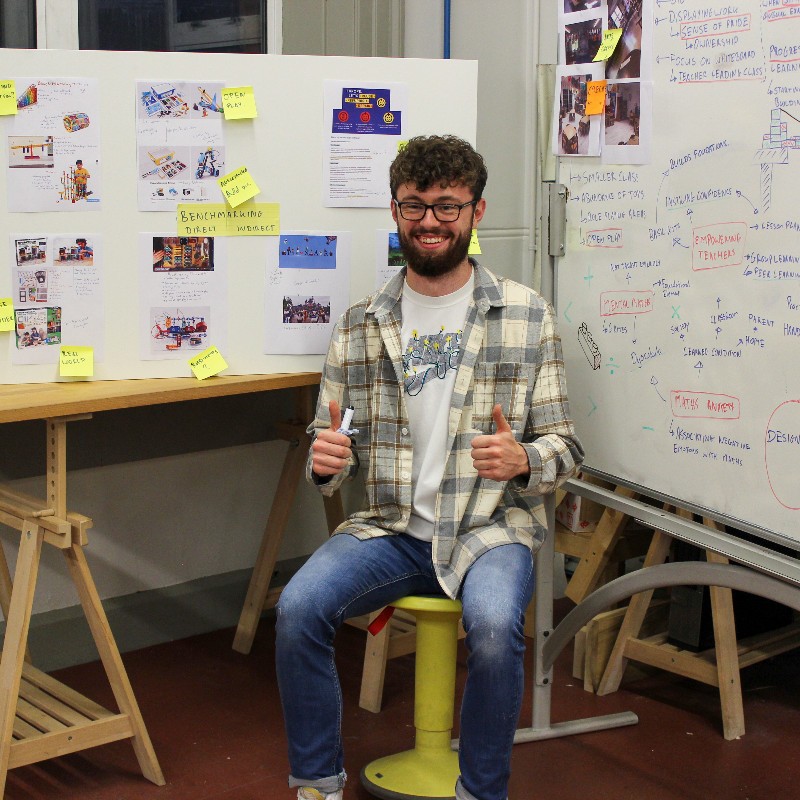What it does
Méadú aims to aid in curbing the development of maths anxiety through providing interactive mathematics lessons for students aged 7 to 12. The board primarily functions as an interactive multiplication table for children to learn up to their 12 times tables.
Your inspiration
The idea for the product came from primary user research within primary schools. Teachers flagged that there was a drop off in physical maths resources for the older year groups in primary education, when the topics increased in difficulty. When asked about topics that are often found difficult to comprehend by student, especially those that have already began to develop a fear of math's, they said that multiplication is often one of the harder concepts to understand and doesn’t have a lot of physical resources. The focus area was then decided and attempts to design a solution began.
How it works
The final product has several features that allow for interactive and hands-on maths learning. These features are: 1. Multiplication Table: The multiplication table is the main feature of the product. It is a 12 by 12 grid showing the multiples of 1 times 1 up to 12 times 12. 2. Sliders: The sliders are used with both the multiplication table and the whiteboard. For the multiplication table the sliders are used to align with input numbers on the edges of the board and intersect to highlight the product of the two numbers. 3. Whiteboard: The whiteboard is located on the underside of the central board and offers the students an open-ended tool for use during lessons. The board can be used for general rough work or drawing when combined with the sliders and their rulers. 4. Maths Fact Sheet: The maths fact sheet is located underneath the central board for easy to access maths facts for use during lessons.
Design process
The design process relied heavily on feedback from three key groups: primary school students, teachers and maths lecturers within the college. In the initial stage, several rough prototypes of different ideas were created and presented to a class for feedback. Based off this feedback the concepts were refined and iterated upon. They began to move to higher fidelity models created in quick succession through laser cutting. This allowed for the prototypes to be fed back into the feedback loops and improvements added. With the initial multiplication use case finalized and aiding student during their lessons the focus shifted to add more use cases for the product within the classroom. Features were added to increase usability such as whiteboard and the maths fact sheet. these received good feedback and “added more depth to the product” from a teacher’s point of view. With the final form and features completed CMF iterations were created through different materials and engravings/markings within the laser cutter. These iterations were again tested, and the final CMF were chosen as translucent acrylic sliders and birch plywood main board. Numerous models were then created to be used in a classroom setting for a lesson to gain final feedback on the design which was mostly positive.
How it is different
The product serves a market segment that is currently lacking physical resources to aid engage children in maths and aid to curb the development of maths anxiety in their later education by building strong foundations. With the rise of technology being used to teach children taking an analog approach to using modern manufacturing methods to produce a product that aids children and promotes hands-on learning is a fresh take. The USP of the product is its physical and interactive nature getting children away from their copies and books transitioning to more practical maths lessons at a younger age to aid them gain a wider understanding of the applications of maths in the real world.
Future plans
Currently, the future plans for the idea are to develop more final products for long-term testing within learning support classrooms in primary schools. These smaller classes are the ideal beachhead market for the product as they will gain the most through using the product. These trials would last a month minimum with feedback taken from both teacher and students. The long plan is to introduce the product into mainstream classrooms and for it to become common place in schools across the country.



Connect